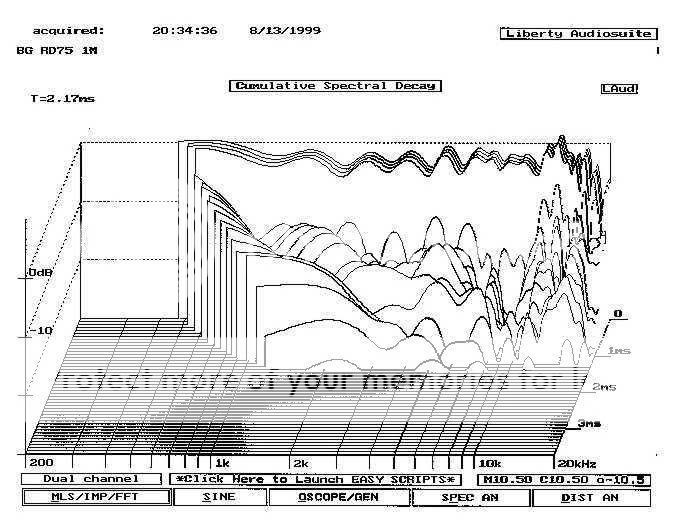I want to fabricate a baffle board with a waveguide machined into it to compliment a Fountek Neo CD2.0 tweeter mounted on the back side. This configuration would be similar in comcept to the Sonist Concerto series design. PRODUCTS
OTOH, the latest issue of Stereophile magzine (Nov. '09) shows a rectangular ribbon with a drastically different waveguide geometry on an Aerial 20T V2 speaker. Stereophile: Stephen Mejias Blog Scroll down towards the bottom for a pic of the cover showing the speaker.
Apparently, not all waveguides are the same. Or, someone is stretching the truth a bit.
Which is the right or better geometry?
Madisound is selling a horn-loaded ribbon nowadays. Interesting item, particularly since some of the prosound companies are getting good results with ribbons that cost $500 a pop. (This one is sixty bucks.)
Madisound:
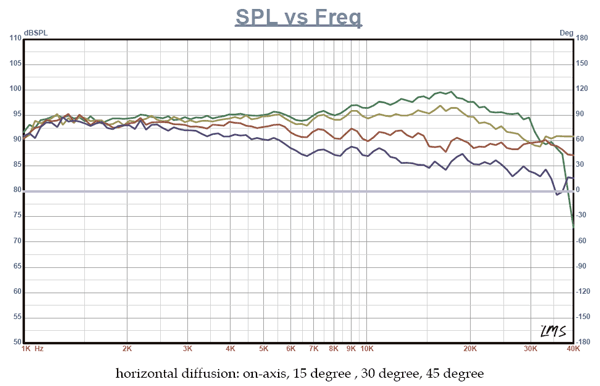
An externally hosted image should be here but it was not working when we last tested it.
Fountek NeoCd3.5H Horn Tweeter: Madisound Speaker Store
Aeriel:
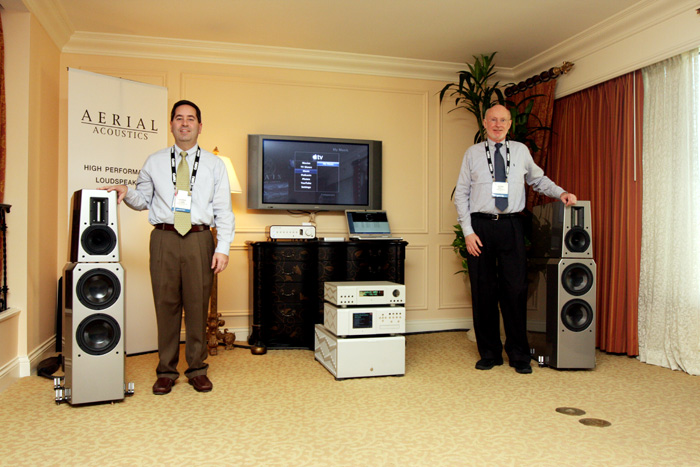
IMHO, the main advantage of a waveguide driven by a ribbon is great CSD, and potentially better extension. In other words, a compression driver will get louder, and it will handle more power, but the compression driver doesn't have that awesome CSD that you get with a ribbon, and the simplicity of a ribbon can sometimes lead to very well behaved output in the top octave.
Or to put it simply, "ribbons are clean."
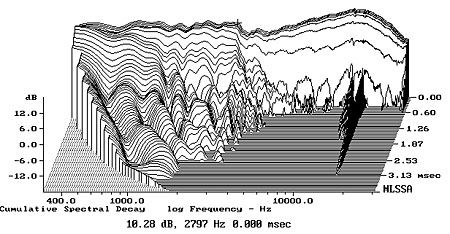
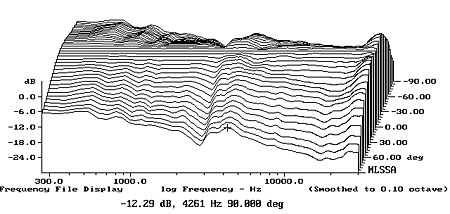
Here's the CSD and directivity of the Aeriel 20T V2. It costs thirty two thousand dollars and uses a waveguide-loaded ribbon. Note how clean the CSD is, and how the on and off-axis energy is consistent.


For comparison's sake, here's the B&C DE250 on a horn, which is a very good compression driver. See how the CSD takes about fives times as long to decay? Those ribbons are fragile, but they are very very light, so the motor of the ribbon exerts tremendous control over them. And you see that in the CSD.
(When you compare the two measurements, note that Brandon's scale is twice as tall as John Atkinson's.)
Or to put it simply, "ribbons are clean."


Here's the CSD and directivity of the Aeriel 20T V2. It costs thirty two thousand dollars and uses a waveguide-loaded ribbon. Note how clean the CSD is, and how the on and off-axis energy is consistent.
For comparison's sake, here's the B&C DE250 on a horn, which is a very good compression driver. See how the CSD takes about fives times as long to decay? Those ribbons are fragile, but they are very very light, so the motor of the ribbon exerts tremendous control over them. And you see that in the CSD.
(When you compare the two measurements, note that Brandon's scale is twice as tall as John Atkinson's.)
Those ribbons are fragile, but they are very very light, so the motor of the ribbon exerts tremendous control over them.
Actually I believe the motor is very weak; ever seen the BL of a ribbon?
Their cleanness is indeed due to the low mass, but the reason is that their areal density is so low that their modes are damped by the air.
I believe it's the case that when the ribbon moves, the mass of the air it displaces is greater than that of the diaphragm, so that it acts as a limp mass damping.
It is purely a mass thing - ribbons have very low mass. With neo prices going through the roof however, so will ribbon prices. The DE250 will stay reasonable.
And John, I simply don't see the huge difference is CSD that you see except for a couple of resonances which I suspect are not the driver. I don't do CSD because I don't see them as all that relavent, but suspect that your Summas have a CSD much like that of the ribbons, but with much better directivity, much higher power and efficiency and all at a much lower cost.
And John, I simply don't see the huge difference is CSD that you see except for a couple of resonances which I suspect are not the driver. I don't do CSD because I don't see them as all that relavent, but suspect that your Summas have a CSD much like that of the ribbons, but with much better directivity, much higher power and efficiency and all at a much lower cost.
I've posted responses cleaner than that. Even those were not acceptable to me. But I have not tried them with the Ultimate Equalizer yet. I would expect much much better results. Below is what I did on a direct radiating driver.IMHO, the main advantage of a waveguide driven by a ribbon is great CSD, and potentially better extension. In other words, a compression driver will get louder, and it will handle more power, but the compression driver doesn't have that awesome CSD that you get with a ribbon, and the simplicity of a ribbon can sometimes lead to very well behaved output in the top octave.
Or to put it simply, "ribbons are clean."


Here's the CSD and directivity of the Aeriel 20T V2. It costs thirty two thousand dollars and uses a waveguide-loaded ribbon. Note how clean the CSD is, and how the on and off-axis energy is consistent.


For comparison's sake, here's the B&C DE250 on a horn, which is a very good compression driver. See how the CSD takes about fives times as long to decay? Those ribbons are fragile, but they are very very light, so the motor of the ribbon exerts tremendous control over them. And you see that in the CSD.
(When you compare the two measurements, note that Brandon's scale is twice as tall as John Atkinson's.)
An externally hosted image should be here but it was not working when we last tested it.
I expect similar performance improvements on horns
The driver itself is not that good, the CSD improvement is due to Ultimate Equalizer from Bodzio Software. Originally I was not aware there could be such effect, little tip from Joachim in the ZDL thread prompted me to look into the effects. It was used with the speakers in my avatar during the Hi End show on Taipei last week. As usual in audio, we always get mixed impressions. As shown in the CSD I posted above, it was EQed based on measurements of the speaker and then remeasured at the same distance (1M). Later I discovered that EQing the near field response (power response?) is more accurate in playback.
I've posted responses cleaner than that. Even those were not acceptable to me. But I have not tried them with the Ultimate Equalizer yet. I would expect much much better results. Below is what I did on a direct radiating driver.
An externally hosted image should be here but it was not working when we last tested it.
I expect similar performance improvements on horns
Comparing a direct radiator to a driver on a waveguide is semi-pointless; the direct radiator will always be cleaner. It's like comparing acceleration figures for a bicycle and a car.
This is a direct result of the fact that the impulse response, frequency response and CSD are all directly related and that one can be derived from another. It's what we've been pointing out to you for a long time. If the FR is flat with a specific bandpass characteristic, no matter how it was attained (passively, actively, DSP), the CSD is going to be comparable. Generally, everything one needs to see is in the FR, the reason a number of us pretty much don't put much emphasis in it, other than highlighting resonances, if the FR is not flat. John K demonstrated this at his site a long, long time ago. What's new is that one can now make a driver or system with linear phase and simultaneously flat frequency response with the consequent system CSD.The driver itself is not that good, the CSD improvement is due to Ultimate Equalizer from Bodzio Software. Originally I was not aware there could be such effect, little tip from Joachim in the ZDL thread prompted me to look into the effects.
Example of ideal LR4 and a driver EQed to a 4th order bandpass:
Energy storage part 1
Energy storage part 2
Here's his system measured response for a standard LR6 with EQed drivers:
An externally hosted image should be here but it was not working when we last tested it.
His system measured response with linear phase for an LR4:
An externally hosted image should be here but it was not working when we last tested it.
Did you never read papers at his site?
Dave
The driver itself is not that good, the CSD improvement is due to Ultimate Equalizer from Bodzio Software. Originally I was not aware there could be such effect, little tip from Joachim in the ZDL thread prompted me to look into the effects. It was used with the speakers in my avatar during the Hi End show on Taipei last week. As usual in audio, we always get mixed impressions. As shown in the CSD I posted above, it was EQed based on measurements of the speaker and then remeasured at the same distance (1M). Later I discovered that EQing the near field response (power response?) is more accurate in playback.
Thanks, I think I have read a little bit about Bodzio software when I look at DSP options in the past. Is there a thread that shows the before and after CSD??
That raises a question. If one does not feel the need for the specific directivity of a waveguide and does not push direct radiators to the point that motor non-linear distortion is an issue, what's the advantage of a waveguide, other than sensitivity?Comparing a direct radiator to a driver on a waveguide is semi-pointless; the direct radiator will always be cleaner. It's like comparing acceleration figures for a bicycle and a car.
I'd like to see what one could do with a good waveguide using the Ultimate Equalizer. I use the term good waveguide since EQ can't fix waveguide problems, but it should be possible to improve the response of the compression driver.
Dave
This is a direct result of the fact that the impulse response, frequency response and CSD are all directly related and that one can be derived from another. It's what we've been pointing out to you for a long time. If the FR is flat with a specific bandpass characteristic, no matter how it was attained (passively, actively, DSP), the CSD is going to be comparable. Generally, everything one needs to see is in the FR, the reason a number of us pretty much don't put much emphasis in it, other than highlighting resonances, if the FR is not flat. John K demonstrated this at his site a long, long time ago. What's new is that one can now make a driver or system with linear phase and simultaneously flat frequency response with the consequent system CSD.
Example of ideal LR4 and a driver EQed to a 4th order bandpass:
Energy storage part 1
Energy storage part 2
Here's his system measured response for a standard LR6 with EQed drivers:
An externally hosted image should be here but it was not working when we last tested it.
His system measured response with linear phase for an LR4:
An externally hosted image should be here but it was not working when we last tested it.
Did you never read papers at his site?
Dave
I know you are not asking me but I read it a while ago . Of course, it never really clicking in with me until your post now. I remember it being one of the reasons I have been wanting a linear phase/ulimtate EQed setup.
FWIW, I think ribbons in waveguides is a great idea. The only downside with my Neopro5i ribbons is the vertical drop even 10deg off axis. To have better control of their directivity is a bonus. IMO there isnt a CD that sounds as good for me has my ribbon designs in the 2KHz to 20KHz range. I have tried to find one including TAD CDs but still for critical music listening Ribbons rule.
That raises a question. If one does not feel the need for the specific directivity of a waveguide and does not push direct radiators to the point that motor non-linear distortion is an issue, what's the advantage of a waveguide, other than sensitivity?
I'd like to see what one could do with a good waveguide using the Ultimate Equalizer. I use the term good waveguide since EQ can't fix waveguide problems, but it should be possible to improve the response of the compression driver.
Dave
Someone needs to get a hold of the new SEOS-15 waveguides, which I think are the best waveguides that exist today based on the measurements I have seen. I would love to see what can be done with them and even the B&C DE250. I would fund that test if someone wants to do it??
early seventies stuf.FWIW, I think ribbons in waveguides is a great idea. The only downside with my Neopro5i ribbons is the vertical drop even 10deg off axis. To have better control of their directivity is a bonus. IMO there isnt a CD that sounds as good for me has my ribbon designs in the 2KHz to 20KHz range. I have tried to find one including TAD CDs but still for critical music listening Ribbons rule.
Ribbon Tweeter Horn Loudspeaker: Decca London/Stanley Kelly - Efficiency, Size, Filter and Frequency Response.
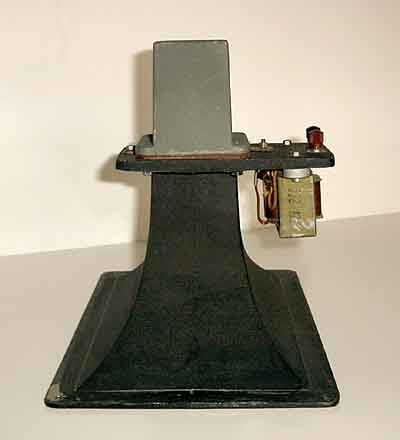
That raises a question. If one does not feel the need for the specific directivity of a waveguide and does not push direct radiators to the point that motor non-linear distortion is an issue, what's the advantage of a waveguide, other than sensitivity?
I'd like to see what one could do with a good waveguide using the Ultimate Equalizer. I use the term good waveguide since EQ can't fix waveguide problems, but it should be possible to improve the response of the compression driver.
Dave
If your not interested in directivity then there is absolutely no need for a waveguide. I have always said that waveguides are for directivity and thats the only reason that I use them.
EQ cannot fix ANY acoustical problems whether they are from waveguides or direct radiators. They can do "perfect" correction at a single point - by making ALL other points worse. Numerous studies have shown that this is a mixed bag - sometimes the sound improves sometimes it degrades. Basically if the problem are not primarily acoustical ones then we can expect an improvement, but if ther are acoustical in nature you should expect them to degrade.
If your not interested in directivity then there is absolutely no need for a waveguide. I have always said that waveguides are for directivity and thats the only reason that I use them.
EQ cannot fix ANY acoustical problems whether they are from waveguides or direct radiators. They can do "perfect" correction at a single point - by making ALL other points worse. Numerous studies have shown that this is a mixed bag - sometimes the sound improves sometimes it degrades. Basically if the problem are not primarily acoustical ones then we can expect an improvement, but if ther are acoustical in nature you should expect them to degrade.
There is a hilarious thread on diymobileaudio.com about JBL's new processor
it's lulz, because it follows the exact same pattern as every thread i've ever read about EQs:
Stage 1: The manufacturer announces a new processor, and everyone on the forum loses their marbles and declares that it will fix all the problems in audio
Stage 2: People wait a year for it to come out, in excited anticipation
Stage 3: The product is released, and people spend the first month talking about how it actually exceeded their wildest expectations
Stage 4: After using it for a month, users begin to complain that the effect is unnatural
Stage 5: After being on the market for a month, users are furiously dumping the processors in the classified section of the same forums, and trying to get pennies on the dollar for their investment
It's funny because it's the same pattern over and over for every single processor I've ever seen in audio.
I understand you position and agree for the most part, but there are issues with drivers that are polar in nature and can to some degree be improved on a polar basis. I would posit a spider resonance as an example. This is seen at most angles of a direct radiator. It can be improved in a way that improves most, if not all axes. But yes, the polar response must be considered in its entirety.EQ cannot fix ANY acoustical problems whether they are from waveguides or direct radiators. They can do "perfect" correction at a single point - by making ALL other points worse. Numerous studies have shown that this is a mixed bag - sometimes the sound improves sometimes it degrades. Basically if the problem are not primarily acoustical ones then we can expect an improvement, but if ther are acoustical in nature you should expect them to degrade.
What makes me curious is the raw response of a compression driver. I would think that there may be a way to improve its response so that when coupled to the waveguide, the wavefront entering the throat of the waveguide might be improved. Are you saying that compression drivers are linear enough that improvements in them are not possible other than some sort of redesign how the compression driver mates with the waveguide? I'm simply not familiar enough with the structures of compression drivers.
Dave
The raw driver would look like this.Thanks, I think I have read a little bit about Bodzio software when I look at DSP options in the past. Is there a thread that shows the before and after CSD??
An externally hosted image should be here but it was not working when we last tested it.
Then in active speaker with Ultimate Equalizer
An externally hosted image should be here but it was not working when we last tested it.
Last edited:
- Home
- Loudspeakers
- Multi-Way
- Geddes on Waveguides
